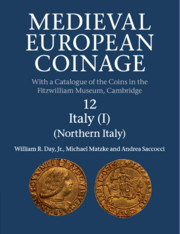6 - veneto
Published online by Cambridge University Press: 11 May 2017
Summary
INTRODUCTION
Historical background
This chapter covers the coinage of north-east Italy, comprehending the present regions of Veneto, Trentino-Alto Adige and Friuli-Venezia Giulia (Map 4). Veneto is the official name of only one of these regions, that of the city of Venice, but in the CNI it was used to indicate a wider area taking in all the Italian territories north of the river Po and east of the drainage basin of the Lago di Garda. There were no compelling historical or linguistic reasons for the choice made by the compilers of the CNI. Since the Middle Ages, the territories covered in this chapter have been divided into as few as two or more than ten different states with the people in them speaking various Italian dialects and even different languages (Italian,German, Slavonic). The only practical reason for putting all of the territories together was probably to fill a single volume of the CNI, and the compilers called it ‘Veneto’ presumably because the greater part of the three regions long appertained to Venice and many of the more important mints were located in the Veneto.
Recent research also suggests that there is a good numismatic basis for retaining the arrangement that the compilers of the CNI chanced upon. Both coin finds and documentary evidence have shown that the three regions formed a homogeneous,well-defined ‘monetary area’.Not only did all the coins produced there circulate freely in all the different states within the three regions, but they also represented almost all of the circulating currency there. Less than 1 per cent of the coins found within the boundaries of what is referred to here as the ‘Veneto’ came from mints located outside the regions (Saccocci 1999a, 49). The role and the function of monetary areas in northern Italy have already been discussed above (see Chapter 1, section (b), pp. 22–4). It is nevertheless noteworthy that the monetary area of the Veneto corresponds almost perfectly to the territories of the ancient Roman X Regio (i.e. the modern regions of the Veneto, Friuli-Venezia Giulia and Istria) and of the later Venetian Terraferma (i.e. the mainland dominions of Venice from the fifteenth to the eighteenth century). It thus forms a medieval bridge of sorts between the ancient and early modern periods.
- Type
- Chapter
- Information
- Medieval European Coinage , pp. 548 - 667Publisher: Cambridge University PressPrint publication year: 2016

